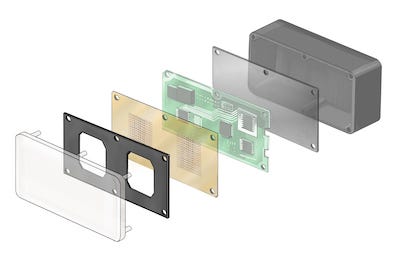Advanced driver assistance systems benefit from new Sabic offerings.
December 3, 2020

Sabic has introduced two new radar-absorbing LNP Stat-Kon compounds for automotive radar sensors, significantly expanding its portfolio of these specialty materials. The new grades, based on polybutylene terephthalate (PBT) resin, may be used for integration with radomes manufactured using PBT material, which can provide superior resistance to automotive chemicals.
They complement and extend Sabic’s existing radar absorbing LNP Stat-Kon compounds, which are based on polyetherimide (PEI) resin for withstanding higher processing temperatures or on polycarbonate (PC) resin for general applications that require high durability and a balance of physical properties. The high radio frequency (RF) absorption of these compounds can help increase detection range and improve signal resolution. Through materials innovation, Sabic is contributing to the growth of automotive radar and the design of next-generation sensors.
|
Radar-absorbing materials are used to shield the field of radar wave transmission and attenuate side waves that can cause ghost images or trigger false actions or alarms. Image: Sabic. |
Radar sensors are widely used in advanced driver assistance systems (ADAS), where they provide capabilities such as blind spot detection, collision avoidance, automatic braking and traffic alerts. Radar-absorbing materials (RAM) are used to shield the field of radar wave transmission and attenuate side waves that can cause ghost images or trigger false actions or alarms. A broader choice of radar absorbing LNP Stat-Kon compounds can help manufacturers to increase flexibility in sensor positioning and function and to help design sensors that can be optimized for vehicle size and other variables.
“Radar sensors are a critical component of the ADAS suite, in part because they can operate in conditions such as poor visibility that impair LiDAR and camera functioning,” said Jeff Xu, LNP Product Manager, Sabic. “To support technology advancement in the radar sensor market, which is rapidly growing, Sabic continues to develop specialty materials that can enhance sensor accuracy and reliability. Our growing portfolio of LNP compounds offers high absorption of radar waves as well as potential cost benefits compared to radar absorbing materials designed for military applications.”
The automotive radar market is forecasted to reach $12.16 billion by 2025, growing at an annual growth rate of 20.8%, according to Grand View Research, Inc. This rapid expansion can be attributed to increased investments in the automotive industry, higher vehicle sales, greater emphasis on safety and innovations in radar technologies. Novel materials are contributing to this growth trajectory by improving sensor performance. Sabic’s new PBT-based LNP Stat-Kon compounds deliver an RF absorption of 67 percent at 77 GHz, which could allow for increased ADAS functionality for the automobile. To keep pace with rapid advancements in radar sensors, Sabic is developing additional grades that are either based on new resins or have higher radar absorbing properties.
Sabic offers extensive expertise in material development and a deep understanding of how radar units are designed and should perform in the automotive environment. The company also has access to innovative dielectric property tests and measurements in a wide range of frequencies, as well as modeling tools capable of performing simulations to help radar sensor manufacturers and automotive OEMs optimize system design and integration.
About the Author(s)
You May Also Like





